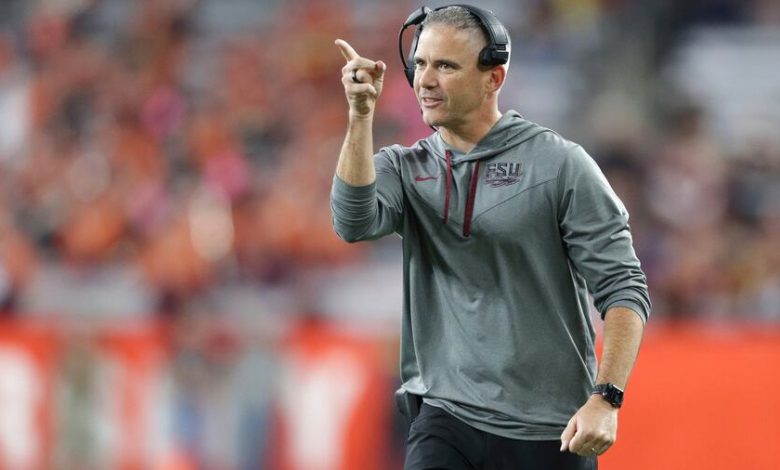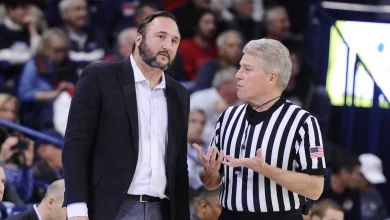Mike Norvell’s seven-figure gamble is under scrutiny, and FSU is once again in hot water due to a transfer portal issue.

Florida State University (FSU) football has been no stranger to controversy and scrutiny in recent years. With high expectations for the program, and a coaching staff determined to return the Seminoles to prominence, head coach Mike Norvell has gambled big—making significant investments, including a seven-figure commitment, to reshape the roster. However, recent issues involving the transfer portal have once again thrust FSU into the spotlight, and not in a positive way. The fallout from these developments has left the program facing serious questions about the decisions made by Norvell and the wider challenges the transfer portal brings to college football.
This article will examine the details of Mike Norvell’s seven-figure gamble, how the decision to invest heavily in the transfer portal has unfolded, and why FSU is now dealing with a significant controversy surrounding its roster-building strategies.
Mike Norvell’s Seven-Figure Gamble: A High-Risk Strategy
When Mike Norvell took over as the head coach of the Florida State Seminoles in 2020, he inherited a program in disarray. The Seminoles were struggling on both sides of the ball, and their recruiting efforts had not produced the kind of talent that had been typical of a powerhouse like FSU in previous decades. In his first few seasons, Norvell worked to instill discipline, restructure the program’s culture, and bring in recruits that could provide a foundation for long-term success. However, it was clear that rebuilding would take time, and he would need to find a way to accelerate that process.
Enter the transfer portal, a tool that has transformed college football recruiting. The portal allows players to leave one program and join another, and in recent years, it has become a crucial method for teams to plug gaps in their rosters. Coaches have increasingly turned to transfers to fill immediate needs, particularly when they are trying to rebuild a program quickly. Norvell was no exception to this trend, and his decision to invest heavily in the portal was a high-risk, high-reward gamble aimed at turning FSU’s fortunes around quickly.
Norvell and his staff used the portal extensively during the 2021 and 2022 offseason periods, signing a series of high-profile transfers, including key players from major programs. With the promise of substantial NIL (Name, Image, and Likeness) deals and the opportunity to contribute immediately, Norvell was able to convince experienced players to come to Tallahassee and help fill critical holes on the roster.
The most notable of these transfer signings came in the form of quarterback Jordan Travis, who, though not a direct transfer portal addition (he had been at FSU for a few years), quickly became the centerpiece of Norvell’s rebuilding efforts. Additionally, players like defensive lineman Jared Verse (from Albany) and wide receiver Johnny Wilson (from Arizona State) became key pieces that helped solidify FSU’s 2023 squad as one of the top teams in the ACC.
Norvell’s gamble appeared to pay off initially. In 2023, FSU showed significant improvement, returning to relevance in the ACC and becoming a legitimate contender for a spot in the College Football Playoff. The Seminoles’ performance in key games, bolstered by their high-profile transfers, raised expectations for the program moving forward. Norvell’s use of the transfer portal had been largely successful in retooling the roster, bringing in experienced talent to complement the homegrown recruits he had brought to the program.
However, despite the success on the field, the heavy reliance on the transfer portal has not come without complications. While the influx of talented players boosted FSU’s chances of success, it has also raised concerns about the long-term sustainability of such a strategy. And, more recently, one of those complications has turned into a controversy that could threaten to undo some of the positive momentum Norvell has worked so hard to build.
FSU’s Transfer Portal Issues: The Recent Controversy
In early January 2025, the FSU football program found itself embroiled in a major controversy involving the transfer portal. It was revealed that the Seminoles had been involved in a series of questionable dealings related to the recruitment of transfers, raising questions about the ethics and legality of some of the program’s recent moves. Specifically, FSU was under fire for its handling of NIL deals, with allegations that certain transfer players had been offered significant financial incentives without following proper procedures.
While the NCAA has yet to formally investigate the allegations, the public outcry surrounding the situation has been significant. Critics argue that FSU’s use of NIL to lure players from the transfer portal could be seen as crossing a line in terms of competitive fairness. Some even suggest that FSU’s recruiting tactics are emblematic of a wider issue in college football, where the increasing commercialization of the sport has led to an environment where money is driving decisions more than actual development and coaching.
These issues have put FSU back in the headlines for the wrong reasons, just as the program was beginning to feel like it was moving in the right direction under Mike Norvell. Instead of focusing on building for the future, FSU now finds itself in the middle of a PR nightmare that could have serious consequences for the program’s reputation, and perhaps its standing within the broader college football landscape.
The Impact on FSU’s Recruiting and Reputation
The transfer portal controversy has broader implications for the future of FSU’s recruiting efforts. While Norvell has successfully used the portal to build a competitive roster, the current situation raises questions about the long-term stability of this approach.
One of the key criticisms is that relying too heavily on transfers may limit the development of younger players within the program. Transfer portal players, while experienced and immediately eligible to play, often come with baggage in terms of fitting into a new system and team culture. Over-reliance on transfers can disrupt a program’s natural recruiting cycle, especially when the transfers come from programs with significantly different philosophies.
Moreover, the controversy surrounding NIL deals adds another layer of uncertainty to FSU’s recruiting approach. With NCAA rules around NIL still evolving, many schools are treading carefully, ensuring that their deals are fully compliant with the governing body’s regulations. FSU’s recent issues raise concerns that the program may be skating too close to the edge, risking penalties or sanctions down the line if the allegations prove true.
FSU has prided itself on its storied history in college football, and a significant part of that reputation stems from its success in recruiting and developing elite high school talent. However, as the college football landscape evolves, with the rise of the transfer portal and NIL deals, there’s growing concern that traditional recruiting models may be undermined. The perception that FSU is relying too heavily on the portal could alienate some of the high school recruits they need to stay competitive long-term.
Norvell’s Response and the Road Ahead
Mike Norvell has not shied away from the scrutiny. In fact, he’s publicly defended his transfer portal strategy, arguing that it’s necessary to keep pace with the changing dynamics of college football. Norvell insists that he has always operated within the boundaries of the rules and has done everything by the book. He has pointed to the success of players like Jordan Travis, Jared Verse, and Johnny Wilson as proof that the transfer portal can be a valuable tool when used responsibly.
That said, the current controversy has placed added pressure on Norvell and the FSU administration. As the NCAA and media continue to scrutinize the situation, it’s possible that FSU could face sanctions or penalties if the allegations about NIL misconduct are substantiated. The program may also need to reassess its recruiting strategy, particularly its heavy reliance on transfers, to ensure that it can maintain long-term competitiveness without sacrificing its core values.
The situation has also shone a spotlight on the broader challenges facing college football programs as the transfer portal becomes an increasingly significant factor in roster-building. Coaches must now navigate the complexities of roster turnover, recruiting regulations, and NIL, all while keeping their teams competitive on the field. The landscape has shifted, and programs that fail to adapt may find themselves falling behind.









